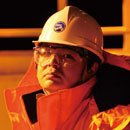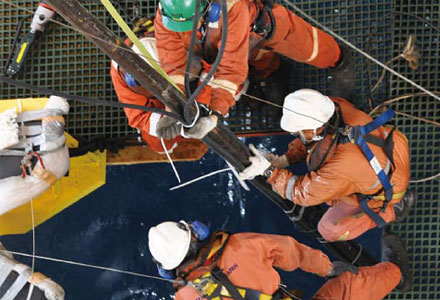
From October through December 2010, as part of Integrated Ocean Drilling Program (IODP) Expedition 332 “Riserless Observatory”, the Deep Sea Drilling Vessel CHIKYU drilled and cased a riserless borehole up to 980 m below the seafloor at the subduction end of the Tonankai Earthquake’s focal region (Site C0002) off the Kii Peninsula. The expedition also successfully carried out the
difficult operation of installing within the cased borehole a long-term observatory, which will help monitor seismic changes within the shallow region of the accretionary prism with very high sensitivity and precision.
(Published in February 2011)
 |
Interviewee Dr. Eiichiro Araki JAMSTEC Technical Development Group,Earthquake and Tsunami Research Project for Disaster Prevention |
Long-term Observatory Installed in the Borehole
Great Progress toward Monitoring Fault Zone of Mega Earthquakes
New Challenges in NanTroSEIZE

|
The monitoring system is assembled while being lowered into the sea. For safety, all work on CHIKYU around the moon pool is carried out by crew and staff wearing lifelines. |
IODP Expedition 332 was carried out over a period of about 50 days from late October 2010, as part of 'Stage 2' of Nankai Trough Seismogenic Zone Experiment (NanTroSEIZE).
The expedition's goals were two-fold: one was to recover and replace the temporary observatory installed into a borehole (Site C0010, water depth: 2,523.7 m) drilled during IODP Expedition 319 (May through August 2009) with a new temporary observatory. The other was to drill, case, and deploy the first permanent observatory, at Site C0002 (water depth: 1,937.5 m). The Expedition 319 Site C0010 borehole (casing depth: 544.3 m below seafloor) is located at the shallowest area of the megasplay fault so that it intersects the fault extending from the seismogenic zone (Site C0010).
The old temporary observatory was installed below a retrievable plug in the casing, and comprised a monitoring package for pore fluid pressure and temperature measurement in the megasplay fault. IODP Expedition 332 recovered this observatory with a tool at the end of the drill pipe from CHIKYU. The data recovered from the observatory included robust and valuable pore fluid pressure and temperature data from over a period of about 15 months since installation. Significantly, the recorded data not only showed isolation of the borehole by the plug, but also showed a tidal response of pore fluid pressure in the formation, as well as signs of past earthquake and tsunami occurrences in the Pacific Basin and crustal deformation associated with them. The new temporary observatory, deployed in the same borehole at Site C0010, is equipped with an osmosampler to detect changes in pore fluid chemistry, in addition to pore fluid pressure and temperature measurement. The instrument package also includes a bio-sampler and an in-situ incubator.

